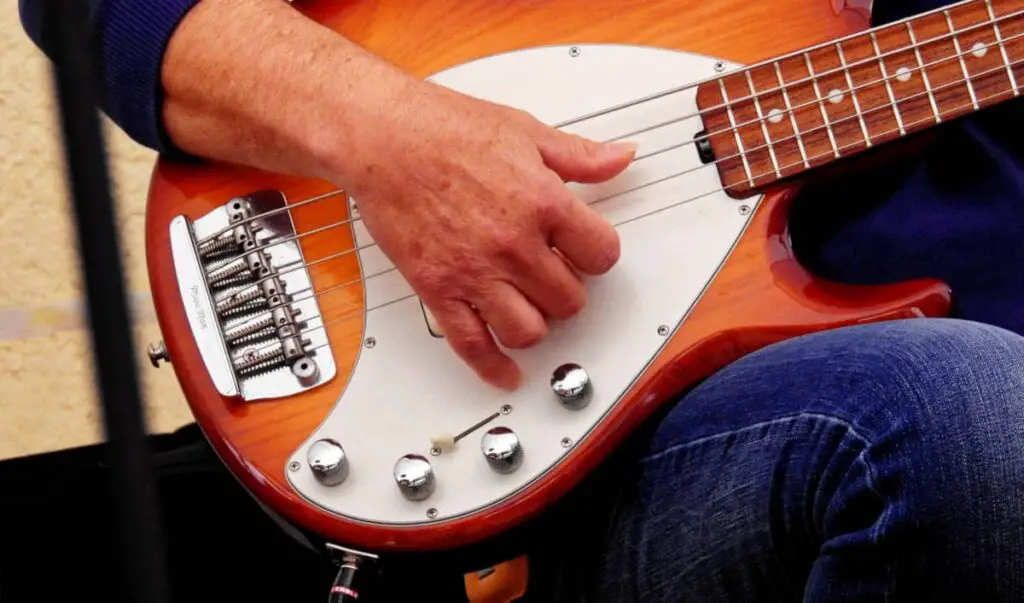Whenever I have the pleasure of trying a new bass, I am quick to try out how different playstyles sound on it. Playing fingerstyle or with a pick never sounds the same on any 2 basses, but the one technique that varies more in sound than any other is slapping. This naturally raises the question: can you play slap bass on any bass guitar?
In general, you can slap any bass guitar. However, not all basses produce the type of sound associated with slap bass. Having high action on your bass will make slapping more difficult and produce a less desirable sound. Slapping also becomes more difficult on basses with strings that are old or too thick.
So you can slap any bass, but I can tell you from experience that not all of them are going to sound great.
But what makes a bass good for slapping, and how can you make your bass sound good when slapped? It’s not complicated, but getting a good slap sound is difficult if you don’t get the basics right.
Can all basses slap?
While all basses can slap, they are not all equally suited for it.
Some 4-strings, such as the Jazz bass is known for being great for slapping. Others, such as Rickenbackers are commonly thought of as unsuited for slapping.
Rather than listing every bass guitar in existence, I am going to list what determines what makes a bass suited for slapping. These factors will both have an impact on playability and sound when playing with your thumb:
- Action – The distance between the strings and the fretboard on your bass is known as Action. As a general rule, lower action makes slapping easier and improves the sound of it. If the action is too high you will need to slap the strings harder which is more damaging for your thumb. This also makes it more difficult to properly pop strings.
- Frets – The slap sound you are producing when hitting the strings with your thumb comes from the string hitting and bouncing of a fret on your bass. Thus, if your frets are in poor condition, this will also negatively impact the sound of your slapping. Fretless basses can be slapped, but they will produce a different sound that is undersired by most bassists. You can learn more about changing your frets here.
- Strings – The years when I incorporated slapping into my playing, is also the the years I bought new strings the most often. Newer strings have brigther high tones and thus produce a more desirable slap sound. You also want thin bass strings when you are slapping. Strings in the 40-55-75-95 range, or close to it, is a great option.
- Pickup – Pickups translate the vibrations of your strings into amplified sound. Thus, if your picksups are poor, or unsuited for slap, they can ruin your sound even if you have done everything else right. As a general rule, you want pickups that sounds full in the lower range and clear in the higher range. For a good slap sound, mid frequencies do not need to be too dominant. If you are going to get new pickups for the purpose of slapping, my recommendation is thus EMGs or Bartolinis.
- EQ – The Equalization on your bass will play a major role in whether it will be able to produce a great slap sound or not. I thus recommend turning the lows and highs up and the mids down (never all the way down though). This will make the frequencies that are paramount for producing a slap bass sound shine through. You can experiment and find a sound that suits your style, but these settings will give you a great baseline for achieving a classic slap sound.
To learn more about other playstyles on the bass, read my guide on what playing bass with a pick actually is like.

What Bass is best for slap?
The Fender Jazz Bass is accepted by most seasoned bassists to be a great bass for slapping, some even consider it the best. The J Bass has been used to success by famous bassists and has seen widespread use for decades. You can also find Jazz basses at entry-level and intermediate price ranges.
I played a Fender Jazz for a while mainly because my favorite bassist, Geddy Lee, played one. Thus I got it mainly to play fingerstyle. However, as I got more into slapping, not only did I notice that the Fender Jazz was great for this, but also that many slap players preferred the J bass for this purpose in particular.
Due to its vast product line, my personal experience with it, and how widely accepted it is as an amazing slap bass, I consider the Fender Jazz the best bass guitar for slapping.
Other great options when it comes to basses for slapping include:
- Music Man Stingray – If you want a more punchy sound, the Stingray is a great alternative to the Jazz bass. This bass also has midrange that is suitable for slapping, where mids can be turned lower without the bass sounding lifeless or dull.
- Warwick Rockbass Corvette 5 – If you are looking for a 5-string bass for slapping or want a bass more fitting for heavier genres like metal or rock, I recommend the Corvette 5. This is a also a great intermediate bass to upgrade to if you are looking to but your second or thrid bass.
- Yamaha TRBX174 – Another great entry-level slap bass is the Yamaha TRBX174. This is a great value bass if you are looking to not spend too much, but want a professional sounding bass too. Noteably this bass also has a position switch with its own slap setting, which produces a funky sound that you can firther EQ to fit your preferences.
Do you need an active bass to slap?
You can slap on both passive and active bass guitars. Slapping an Active bass is fitting in bands where it is difficult for the bass to be heard among the other instruments. A passive bass is better suited to be slapped in bands where the bass is heard more easily.
Whether you should go with active or passive for slap bass is thus mainly a question of what type of slap sound you are looking to achieve. The genre and lineup of your band also play a big role in how you want your bass to cut through the mix.
Unsure about the difference between active and passive basses? Sweetwater Sound has written a simple, yet in-depth explanation here.
In terms of what sound you can expect in terms of sound, passive basses will produce a more expressive tone. This is preferable if you want subtle details in your playing to shine through, which is more fitting in a band where the bass gets a lot of space.
Active basses have a clearer and brighter tone. This can be a great advantage if you a band where it is hard for the bass to cut through the other instruments.
If you are unsure about whether you want a bass with active or passive pickups, you should consider getting a bass with both, such as the Fender Deluxe Precision Bass Special.
Conclusion
You can slap any bass, and there are many steps you can take to improve the slap sound of all basses.
For basses such as Rickenbackers or Hofner violins, you are generally better of finding a different bass to slap. Bassists like Les Claypool, have made slapping a Rickenbacker work and proved that it can be done. However, getting a good sound and playing the bass is difficult, and choosing a bass that is intended to be slapped instead is generally a better option.
With all that said, slap is a distinct technique that every bassist has a different opinion on. Thus, the tips in this article should be considered guidelines that you should use to find a starting point for your sound. After you find a sound that works, not only is it possible to tweak it to your style, it is an essential part of what being a bassist is all about.

